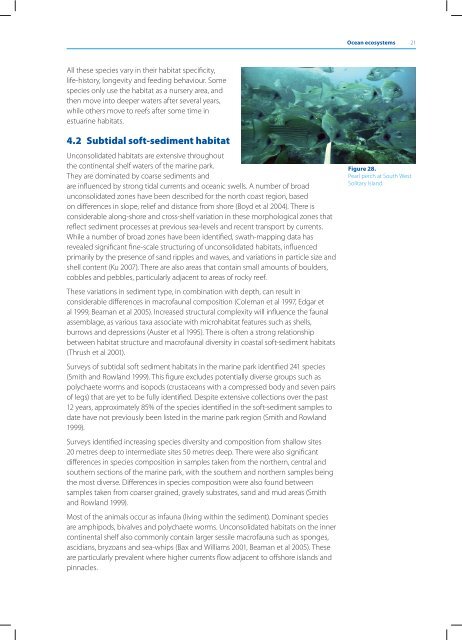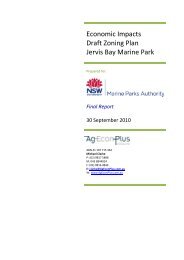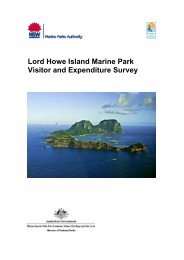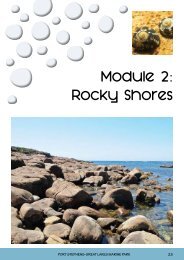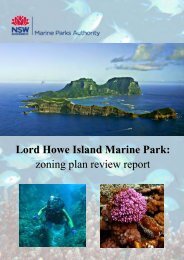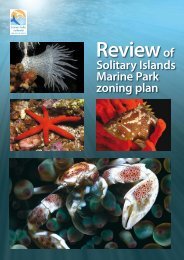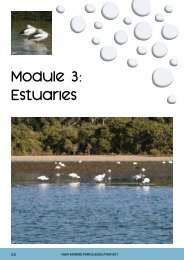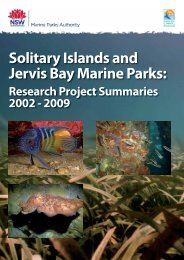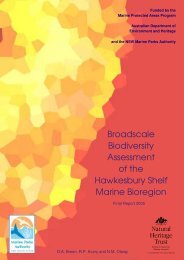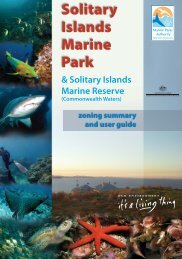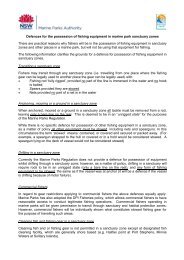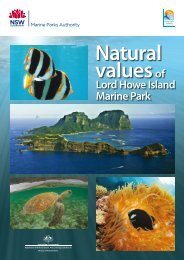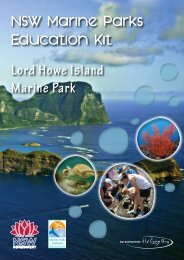Natural values of the Solitary Islands Marine Park - Marine Parks ...
Natural values of the Solitary Islands Marine Park - Marine Parks ...
Natural values of the Solitary Islands Marine Park - Marine Parks ...
- No tags were found...
Create successful ePaper yourself
Turn your PDF publications into a flip-book with our unique Google optimized e-Paper software.
Ocean ecosystems 21All <strong>the</strong>se species vary in <strong>the</strong>ir habitat specificity,life-history, longevity and feeding behaviour. Somespecies only use <strong>the</strong> habitat as a nursery area, and<strong>the</strong>n move into deeper waters after several years,while o<strong>the</strong>rs move to reefs after some time inestuarine habitats.4.2 Subtidal s<strong>of</strong>t-sediment habitatUnconsolidated habitats are extensive throughout<strong>the</strong> continental shelf waters <strong>of</strong> <strong>the</strong> marine park.They are dominated by coarse sediments andare influenced by strong tidal currents and oceanic swells. A number <strong>of</strong> broadunconsolidated zones have been described for <strong>the</strong> north coast region, basedon differences in slope, relief and distance from shore (Boyd et al 2004). There isconsiderable along-shore and cross-shelf variation in <strong>the</strong>se morphological zones thatreflect sediment processes at previous sea-levels and recent transport by currents.While a number <strong>of</strong> broad zones have been identified, swath-mapping data hasrevealed significant fine-scale structuring <strong>of</strong> unconsolidated habitats, influencedprimarily by <strong>the</strong> presence <strong>of</strong> sand ripples and waves, and variations in particle size andshell content (Ku 2007). There are also areas that contain small amounts <strong>of</strong> boulders,cobbles and pebbles, particularly adjacent to areas <strong>of</strong> rocky reef.These variations in sediment type, in combination with depth, can result inconsiderable differences in macr<strong>of</strong>aunal composition (Coleman et al 1997, Edgar etal 1999, Beaman et al 2005). Increased structural complexity will influence <strong>the</strong> faunalassemblage, as various taxa associate with microhabitat features such as shells,burrows and depressions (Auster et al 1995). There is <strong>of</strong>ten a strong relationshipbetween habitat structure and macr<strong>of</strong>aunal diversity in coastal s<strong>of</strong>t-sediment habitats(Thrush et al 2001).Surveys <strong>of</strong> subtidal s<strong>of</strong>t sediment habitats in <strong>the</strong> marine park identified 241 species(Smith and Rowland 1999). This figure excludes potentially diverse groups such aspolychaete worms and isopods (crustaceans with a compressed body and seven pairs<strong>of</strong> legs) that are yet to be fully identified. Despite extensive collections over <strong>the</strong> past12 years, approximately 85% <strong>of</strong> <strong>the</strong> species identified in <strong>the</strong> s<strong>of</strong>t-sediment samples todate have not previously been listed in <strong>the</strong> marine park region (Smith and Rowland1999).Surveys identified increasing species diversity and composition from shallow sites20 metres deep to intermediate sites 50 metres deep. There were also significantdifferences in species composition in samples taken from <strong>the</strong> nor<strong>the</strong>rn, central andsou<strong>the</strong>rn sections <strong>of</strong> <strong>the</strong> marine park, with <strong>the</strong> sou<strong>the</strong>rn and nor<strong>the</strong>rn samples being<strong>the</strong> most diverse. Differences in species composition were also found betweensamples taken from coarser grained, gravely substrates, sand and mud areas (Smithand Rowland 1999).Most <strong>of</strong> <strong>the</strong> animals occur as infauna (living within <strong>the</strong> sediment). Dominant speciesare amphipods, bivalves and polychaete worms. Unconsolidated habitats on <strong>the</strong> innercontinental shelf also commonly contain larger sessile macr<strong>of</strong>auna such as sponges,ascidians, bryzoans and sea-whips (Bax and Williams 2001, Beaman et al 2005). Theseare particularly prevalent where higher currents flow adjacent to <strong>of</strong>fshore islands andpinnacles.Figure 28.Pearl perch at South West<strong>Solitary</strong> Island.


